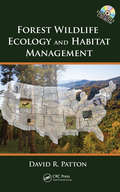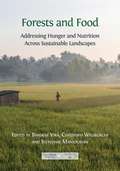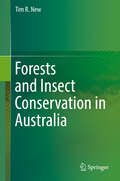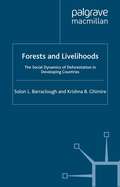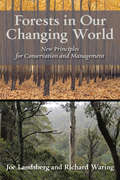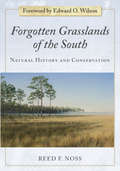- Table View
- List View
Forest Wildlife Ecology and Habitat Management
by David R. PattonAcross the continental United States, one can identify 20 distinct forest cover types. Most of these are to be found on federal lands managed by the U.S. Forest Service and Bureau of Land Management. Those responsible for the management of trees that form the 20 different cover types and the diversity of forest wildlife that reside in them must hav
Forestry Applications of Airborne Laser Scanning: Concepts and Case Studies (Managing Forest Ecosystems #27)
by Matti Maltamo Erik Næsset Jari VauhkonenAirborne laser scanning (ALS) has emerged as one of the most promising remote sensing technologies to provide data for research and operational applications in a wide range of disciplines related to management of forest ecosystems. This book provides a comprehensive, state-of-the-art review of the research and application of ALS in a broad range of forest-related disciplines, especially forest inventory and forest ecology. However, this book is more than just a collection of individual contributions – it consists of a well-composed blend of chapters dealing with fundamental methodological issues and contributions reviewing and illustrating the use of ALS within various domains of application. The reviews provide a comprehensive and unique overview of recent research and applications that researchers, students and practitioners in forest remote sensing and forest ecosystem assessment should consider as a useful reference text.
Forestry Measures for Ecologically Controlling Non-point Source Pollution in Taihu Lake Watershed, China
by Jianfeng ZhangThis book mainly focuses on ecological approaches for preventing and controlling non-point source (NPS) pollution on the basis of forestry measures. In addition to the effects of ecological control, it introduces readers to the characteristics of NPS pollution in Taihu Lake watershed, water eutrophication evaluation methods, and potential countermeasures. Given the crucial role of surface runoff and soil erosion in producing water pollution, the book presents forestry measures to combat them, such as the creation of public welfare forests, urban forestry, planting techniques for hedgerows on slope land, the establishment of shelter belts, nitrogen and phosphorus absorption by hydrophytes, and sustainable management for wetlands. Moreover, the results are supplemented by a wealth of numerical calculations, tables, figures and photographs. The book offers a valuable guide for researchers, educators and professionals working in the areas of water environment, water security and ecological construction.Prof. Jianfeng Zhang works at the Institute of Subtropical Forestry, Chinese Academy of Forestry, Fuyang, China.
Forestry Pesticide Aerial Spraying: Spray Droplet Generation, Dispersion, and Deposition (Environmental Science and Technology Library #12)
by J.J. Picot D.D. KristmansonIntroduced to the technical aspects of forestry aerial spraying in the mid-1970's, we were immediately impressed by the complexity of the process of delivering pesticide to foliage. At that time, there was a vigorous public debate in New Brunswick about the ecological and public h~alth impacts of the annual spray program for the control of defoliation of spruce and fir trees by the spruce budworm. The forest industry is important to the province and changes to the established procedures of budworm control could have major economic implications. A rational debate required reliable information about the mechanics of the spraying process. There was a need to supply missing information as to required pesticide application rates, atomizer performance, off-target drift and deposit, and the effects of weather and aircraft operating factors. We were invited to initiate a research program in this domain by New Brunswick forest management officials, and what follows in this book is a logical and quantitative description of the overall process based on our own research and that of others over the intervening years. After a short introduction to aerial spraying, we begin (Chapter 2) by describing forest stands in terms of their interaction with suspended atmospheric particulate material carried along by the wind and susceptible to deposition on foliage. We introduce foliage simulators and their use in measuring the deposit of sprayed pesticide on foliage, the "biological interface" between pest and pesticide.
Forests and Food: Addressing Hunger And Nutrition Across Sustainable Landscapes
by Bhaskar Vira Christoph Wildburger Stephanie MansourianAs population estimates for 2050 reach over 9 billion, issues of food security and nutrition have been dominating academic and policy debates. A total of 805 million people are undernourished worldwide and malnutrition affects nearly every country on the planet. Despite impressive productivity increases, there is growing evidence that conventional agricultural strategies fall short of eliminating global hunger, as well as having long-term ecological consequences. Forests can play an important role in complementing agricultural production to address the Sustainable Development Goals on zero hunger. Forests and trees can be managed to provide better and more nutritionally-balanced diets, greater control over food inputs—particularly during lean seasons and periods of vulnerability (especially for marginalised groups)—and deliver ecosystem services for crop production. However forests are undergoing a rapid process of degradation, a complex process that governments are struggling to reverse. This volume provides important evidence and insights about the potential of forests to reducing global hunger and malnutrition, exploring the different roles of landscapes, and the governance approaches that are required for the equitable delivery of these benefits. Forests and Food is essential reading for researchers, students, NGOs and government departments responsible for agriculture, forestry, food security and poverty alleviation around the globe.
Forests and Forestry of West Bengal: Survey and Analysis
by Gautam Kumar DasThis book explains several basic concepts of forests and forestry research like social distancing of trees, solitary trees, green infrastructure of trees including typical forest stands like pocket forests, forgotten forests, community forests, and social forestry from one forest stand to another scattered in the districts of West Bengal. In the field of forest floors, depleting status of the forests stimulates to find out different models of afforestation programme like tree-island and rescue forest strategy through plantation programme. Huge loss of tree canopy ravaged by the series of cyclonic storms particularly in the districts of South Bengal seems to be recovered by bioeconomic model with the implementation of social forestry schemes. Thoughts of such models incited the author to go through statistical analysis on different matters and parameters of the forest stands. Determination of physico-chemical parameters of the forest soil are carried on hand in hand with the identification of Alfisol profile exposures in the forest floors. For finding out the present status of forests, district-wise review is worked out. Though scattered in the format of the forest patches, forest stands in the Jungle Mahal are remarkably interesting for any surveyor or tree-lover. Because of the reasons, surveys in the specific forest lands like Joypur and Beliatore of Bankura district and Garh Jangal and Aduria Forests under Bardhaman Forest Division are given special impetus for statistical measures, soil properties analysis, and identification of vegetation pattern. All these salient features inspire the author to take an attempt disseminating information and related characteristics of the forests and forestry of West Bengal. Researchers and students will get sufficient material from this book to enrich their knowledge on the forest environment and the author believes that this book will act as the pioneer work for the flourishment and amelioration of the forestry of West Bengal.
Forests and Insect Conservation in Australia
by Tim R. NewLosses of forests and their insect inhabitants are a major global conservation concern, spanning tropical and temperate forest regions throughout the world. This broad overview of Australian forest insect conservation draws on studies from many places to demonstrate the diversity and vulnerability of forest insects and how their conservation may be pursued through combinations of increased understanding, forest protection and silvicultural management in both natural and plantation forests. The relatively recent history of severe human disturbance to Australian forests ensures that reasonably natural forest patches remain and serve as ‘models’ for many forest categories. They are also refuges for many forest biota extirpated from the wider landscapes as forests are lost, and merit strenuous protection from further changes, and wider efforts to promote connectivity between otherwise isolated remnant patches. In parallel, the recent attention to improving forest insect conservation in harmony with insect pest management continues to benefit from perspectives generated from better-documented faunas elsewhere. Lessons from the northern hemisphere, in particular, have led to revelations of the ecological importance and vulnerability of many insect taxa in forests, together with clear evidence that ‘conservation can work’ in concert with wider forest uses. A brief outline of the variety of Australian tropical and temperate forests and woodlands, and of the multitude of endemic and, often, highly localised insects that depend on them highlights needs for conservation (both of single focal species and wider forest-dependent radiations and assemblages). The ways in which insects contribute to sustained ecological integrity of these complex ecosystems provide numerous opportunities for practical conservation.
Forests and Livelihoods: The Social Dynamics of Deforestation in Developing Countries (International Political Economy Series)
by S. Barraclough K. GhimireThe social dynamics of deforestation and of forest protection are the ongoing interactions amongst social actors and processes that determine the use and management of forests. Based on a vast amount of research and detailed case-studies in Brazil, Central America, Nepal and Tanzania as well as several papers dealing with wider themes and regions, this book argues that most current discussions of increased rates of deforestation and perceived accompanying environmental crises are overly simplistic. Institutional reforms and policy measures that have been undertaken in developing countries usually failed to protect either the forests or people's livelihoods. Technical solutions to deforestation are only one element in what are essentially political questions. The central issue is not how to halt deforestation but rather how to manage forest areas and natural resources in order to meet social goals on a more equitable and sustainable basis. Conventional wisdom that attributes deforestation primarily to peasant ignorance and population growth is questioned as are other single factor explanations such as market and policy failures.
Forests and Woodlands (Habitat Explorer)
by Nick BakerA practical guide for kids aged 7-11, by popular Really Wild Show presenter Nick Baker, full of exciting things to see and do pretty much everywhere.
Forests as Complex Social and Ecological Systems: A Festschrift for Chadwick D. Oliver (Managing Forest Ecosystems #41)
by Patrick J. Baker David R. Larsen Alark SaxenaProfessor Chadwick Dearing Oliver has made major intellectual contributions to forest science and natural resources management. Over the course of his career he has actively sought to bring research and practice together through synthesis, outreach, and capacity-building. A common thread throughout his career has been complexity and how we as a society understand and manage complex systems. His work on forest stand dynamics, landscape management, and sustainability have all focused on the emergent properties of complex ecological and/or social systems. This volume celebrates a remarkable career through a diverse group of former students and colleagues who work on a wide range of subject areas related to the management of complex natural resource systems. Over the past decade there has been considerable discussion about forests as complex adaptive systems. Advances in remote sensing, social methods, and data collection and processing have enabled more detailed characterisations of complex natural systems across spatial and temporal scales than ever before. Making sense of these data, however, requires conceptual frameworks that are robust to the complexity of the systems and their inherent dynamics, particularly in the context of global change. This volume presents a collection of cutting-edge research on natural ecosystems and their dynamics through the lens of complex adaptive systems. It includes contributions by a wide range of authors from academia, NGOs, forest industry, and governmental organisations with diverse perspectives on forests and natural resources management. Each chapter offers new insights into how these systems can be made more resilient to ensure that they provide a diversity of ecological and social values well into the future. Together they provide a robust way of thinking about the many challenges that natural ecosystems face and how we as society may best address them.
Forests: Elements of Silvology
by Roelof A.A. OldemanSilvology is the general science of forest ecosystems, without the usual division between Man and Nature. This systematic treatment of forests intends to integrate and harmonize existing approaches with the help of systems modeling in a hierarchy of close system levels, according to criteria of biological architecture, biomass production and species composition. Scientists and practitioners will appreciate this synoptic treatment of forests and their ecology, allowing the balance of holistic and reductionist viewpoints, and the placement of phenomena and techniques. Topics covered include: - introduction of the methods, - sections on forest organisms, - a special chapter on trees, - eco-units, i.e. forest ecosystems developing after some zero-event like fire, storm or waterlogging, - silvatic mosaics built by the eco-units of different size, architecture and species composition, - a summary of silvological rules determining system's behaviour at every level, e.g. fragmentation and fusion, transfer of functions, irreversibility and process oscillation.
Forests for the People: The Story of America's Eastern National Forests
by Christopher Johnson David GovatskiAt the turn of the twentieth century, widespread clearcutting resulted in ecological ruin and devastating fires in America’s Eastern forests. A coalition of citizens, organizations, and business and political leaders fought against this pattern, and in 1911, they achieved a landmark victory with the Weeks Act, which protected millions of acres of Eastern forests. Forests for the People tells the fascinating story of this vital legislation and the citizens and organizations that made it a reality.While these protected forests survive today, many of the critical issues facing American forests in the twentieth century persist, and new threats have arisen—including oil shale drilling, invasive species, and development around national parks. In Forests for the People, Christopher Johnson and David Govatski draw upon the lessons and victories of the past to examine the vital issues facing American forests today and illuminate paths to better forest management.
Forests in Development: A Vital Balance
by Tomás Schlichter and Leopoldo MontesForests in Development: A Vital Balance, shows some of the main advances in forestry over the six years spanning between the XII World Forestry Congress in Canada and the XIII WFC held in Buenos Aires. The book covers most of the themes of the XIII WFC, from biodiversity through production, policies, environmental services, and economic aspects, linked by sustainability. It provides a comprehensive view of forestry today, conveying its different aspects through one solid piece addressed by authors whose work denotes a concept of sustainable forest management which is not so much a puzzle laboriously put together as a many-faced unity, steered to achieve ultimately a better quality of living for present and future generations.
Forests in Our Changing World: New Principles for Conservation and Management
by Joe Landsberg Richard WaringScientists tell us that climate change is upon us and the physical world is changing quickly with serious implications for biodiversity and human well-being. Forests cover vast regions of the globe and serve as a first line of defense against the worst effects of climate change, but only if we keep them healthy and resilient.Forests in Our Changing World tells us how to do that. Authors Joe Landsberg and Richard Waring present an overview of forests around the globe, describing basic precepts of forest ecology and physiology and how forests will change as earth’s climate warms. Drawing on years of research and teaching, they discuss the values and uses of both natural and plantation-based forests. In easy-to-understand terms, they describe the ecosystem services forests provide, such as clean water and wildlife habitat, present economic concepts important to the management and policy decisions that affect forests, and introduce the use of growth-and-yield models and remote-sensing technology that provide the data behind those decisions.This book is a useful guide for undergraduates as well as managers, administrators, and policy makers in environmental organizations and government agencies looking for a clear overview of basic forest processes and pragmatic suggestions for protecting the health of forests.
Forests of Iran: A Treasure from the Past, a Hope for the Future (Plant and Vegetation #10)
by Khosro Sagheb Talebi Toktam Sajedi Mehdi PourhashemiThe work describes the general ecological aspects of Iran as well as West and Central Asia in the introduction. The book includes three chapters, each describing the climate, geology and soil characteristics, vegetation and forest types, site demands of the main tree species and the ecogram of them, management and socio-economic issues of three different phytogeographical regions, mainly the Hyrcanian, Irano-Turanian, and Saharo-Sindian. Each chapter contains a table for introducing the English and Botanical names of the plant species mentioned in the chapter. The information presented in this book is based on personal experiences and results of research projects of the authors, as well as experiences of other forest scientists in Iran. The references are given at the end of each chapter separately. The book contains 10 tables, 37 black and white and 55 color pictures.
Forests of Southeast Europe Under a Changing Climate: Conservation Of Genetic Resources (Advances In Global Change Research #65)
by Mirjana Šijačić-Nikolić Jelena Milovanović Marina NonićThis book integrates the different prospective, scientific and practical experience of researchers as well as beneficiaries and stakeholders in the field of forest conservation in Southeast Europe. The book stresses the importance of improving the adaptability of these ecosystems to the impacts of climate change. Gathered around a common idea, the book presents the latest results in forest genetic resources conservation at national and regional level. The chapters are written by experts from: Bosnia and Herzegovina, Bulgaria, Croatia, FYR Macedonia, Greece, Montenegro, Romania, Serbia and Slovenia. The book presents the current state, legal and institutional framework for conservation and management of forest genetic resources, case studies and best practices in the application of different conservation methods and techniques (in situ and ex situ) as well as climate change aspects in this area. This book will be of particular interest to scientists and experts in the field of forestry, environmental protection and rural development, bachelor, master and doctoral students, as well as for anyone interested in the conservation issues fuelled by ethical and economic motives.
Forests to Climate Change Mitigation: Clean Development Mechanism in Bangladesh (Environmental Science and Engineering)
by Md. Danesh Miah Man Yong Shin Masao KoikeToday, the effect of global climate change is clear to all. It is clearly dangerous in developing countries such as Bangladesh. The industrial revolution caused major changes in technology, socio-economy and cultures in the late 18th and early 19th century, beginning in Britain and spreading throughout the world. The technology dominated economy was mostly dependent on energy produced from fossil fuel, which still holds true today. It is well known that fossil fuel burning has increased the GHGs to the atmosphere, thus creating global warming. Among the GHGs, the concentration of CO2 has been confirmed as the largest. Terrestrial ecosystems are clearly influencing the concentration of GHGs in the atmosphere. Greenhouse gases are constantly entering and leaving the atmosphere. Actively growing trees and other plants absorb CO2 from the atmosphere, combine it with water through photosynthesis and create sugars and more stable carbohydrates. Through this process, trees capture and store atmospheric CO2 in vegetation, soils and biomass products. The Kyoto Protocol, in 1997, explored a flexible mechanism, CDM (Clean Development Mechanism) where Annex I and non-Annex I parties interact for climate change mitigation. Forestry activities have been considered important in the arena of climate change as they act both as a sink and sources of carbon. The purpose of this book is to highlight the means of efficiently reducing global warming through forestry options in Bangladesh and the positive implications of CDM.
Forged: An Altered Series Prequel (Altered)
by Jennifer RushBefore Anna and Sam, there was Dani and Sam.There's one rule that all Branch operatives must live by: No attachments. When Dani O'Brien entered the Branch, she planned to trade her freedom so that her family could have a better life. But joining up with the mysterious organization is more than she bargained for. Branch head Connor watches over her closely--too closely. The training is brutal, the experiments are secret, and the missions promise to be anything but ordinary. The only thing getting Dani through each day is the hope that she'll run into Sam--a young man, about her age, who wears the world on his shoulders.Find out how it all began in this short-story prequel to Jennifer Rush's thrilling and suspenseful Altered series.
Forget Me Not: Finding the forgotten species of climate-change Britain
by Sophie PavelleJoin Sophie Pavelle on a low-carbon journey around Britain in search of ten animals and habitats threatened by climate change in the 21st centuryForget-me-not – a beautiful flower and a plea from our islands' wildlife. When climate change has driven dozens of our most charismatic species to extinction, will they be forgotten? Like many of her generation, Sophie Pavelle is determined to demand action on climate change. In her hilarious and thought-provoking first book, she describes the trips she took to see ten rare native species: species that could disappear by 2050 and be forgotten by the end of the century if their habitats continue to decline. Sophie challenged herself to find them the low-carbon way, travelling the length of Britain on foot, by bicycle, in an electric car, by kayak, on ferries and in a lot of trains. From Bodmin Moor to the Orkney Islands, Sophie encountered species on the frontline of climate change in Britain. Which are going to be seriously affected, and why? Could some bounce back from the brink? Or are we too late to save them? Forget Me Not is a clarion call: we all need to play a part in tackling this most existential of threats. Everyone can see wildlife in the British Isles without contributing to its destruction. With joyful irreverence, Sophie shows us we can dare to hope. Journey with her, and she may even inspire you to take action for nature and head out on your own low-carbon adventure.
Forgotten Grasslands of the South: Natural History and Conservation
by Reed F NossForgotten Grasslands of the South is the study of one of the biologically richest and most endangered ecosystems in North America. In a seamless blend of science and personal observation, renowned ecologist Reed Noss explains the natural history of southern grasslands, their origin and history, and the physical determinants of grassland distribution, including ecology, soils, landform, and hydrology.In addition to offering fascinating new information about these little-studied ecosystems, Noss demonstrates how natural history is central to the practice of conservation. Although theory and experimentation have recently dominated the field of ecology, ecologists are coming to realize how these distinct approaches are not divergent but complementary, and that pursuing them together can bring greater knowledge and understanding of how the natural world works and how we can best conserve it.This long-awaited work sets a new standard for scientific literature and is essential reading for those who study and work to conserve the grasslands of the South as well as for everyone who is fascinated by the natural world.
Forgotten Healers: Women and the Pursuit of Health in Late Renaissance Italy (I Tatti studies in Italian Renaissance history #24)
by Sharon T. StrocchiaIn Renaissance Italy women from all walks of life played a central role in health care and the early development of medical science. Observing that the frontlines of care are often found in the household and other spaces thought of as female, Sharon Strocchia encourages us to rethink women’s place in the history of medicine.
Forgotten People, Forgotten Diseases: The Neglected Tropical Diseases and their Impact on Global Health and Development (ASM Books)
by Peter J. HotezForgotten People, Forgotten Diseases Second Edition The neglected tropical diseases (NTDs) are the most common infections of the world's poor, but few people know about these diseases and why they are so important. This second edition of Forgotten People, Forgotten Diseases provides an overview of the NTDs and how they devastate the poor, essentially trapping them in a vicious cycle of extreme poverty by preventing them from working or attaining their full intellectual and cognitive development. Author Peter J. Hotez highlights a new opportunity to control and perhaps eliminate these ancient scourges, through alliances between nongovernmental development organizations and private-public partnerships to create a successful environment for mass drug administration and product development activities. Forgotten People, Forgotten Diseases also Addresses the myriad changes that have occurred in the field since the previous edition. Describes how NTDs have affected impoverished populations for centuries, changing world history. Considers the future impact of alliances between nongovernmental development organizations and private-public partnerships. Forgotten People, Forgotten Diseases is an essential resource for anyone seeking a roadmap to coordinate global advocacy and mobilization of resources to combat NTDs.
Forgotten People, Forgotten Diseases: The Neglected Tropical Diseases and their Impact on Global Health and Development (ASM Books)
by Peter J. HotezForgotten People, Forgotten Diseases Second Edition The neglected tropical diseases (NTDs) are the most common infections of the world's poor, but few people know about these diseases and why they are so important. This second edition of Forgotten People, Forgotten Diseases provides an overview of the NTDs and how they devastate the poor, essentially trapping them in a vicious cycle of extreme poverty by preventing them from working or attaining their full intellectual and cognitive development. Author Peter J. Hotez highlights a new opportunity to control and perhaps eliminate these ancient scourges, through alliances between nongovernmental development organizations and private-public partnerships to create a successful environment for mass drug administration and product development activities. Forgotten People, Forgotten Diseases also Addresses the myriad changes that have occurred in the field since the previous edition. Describes how NTDs have affected impoverished populations for centuries, changing world history. Considers the future impact of alliances between nongovernmental development organizations and private-public partnerships. Forgotten People, Forgotten Diseases is an essential resource for anyone seeking a roadmap to coordinate global advocacy and mobilization of resources to combat NTDs.
Forgotten People, Forgotten Diseases: The Neglected Tropical Diseases and Their Impact on Global Health and Development (ASM Books)
by Peter J. HotezThe neglected tropical diseases (NTDs) are among the most common infections of the world’s poorest people and have profound ramifications on affected populations, including physical, mental, social, and economic. This third edition of Forgotten People, Forgotten Diseases coincides with the third decade of the NTDs movement, which has given access to essential NTD preventative treatments and medications to more than 1 billion people. Professor Peter Hotez, MD, PhD, one of the founders of the NTD movement, discusses how the NTD space evolved and control was implemented against these ancient scourges, through alliances between nongovernmental development organizations and private-public partnerships. Forgotten People, Forgotten Diseases also Reports on the health and economic effects of the NTDs, and the challenges of measuring diseases that do not always kill, but adversely affect productivity, child development, pregnancy outcome, and economic development. Lays a roadmap for continued control of existing and newly identified NTDs and spotlights potential opportunities for reducing global poverty and “repairing the world.” Describes a global initiative to provide annual mass drug administration for more than one billion people affected by NTDs. Highlights the role of innovation and product development partnerships for new treatments and vaccines. Explains how science and vaccine diplomacy ensure that a new generation of biotechnologies reaches the world’s poorest people. Forgotten People, Forgotten Diseases remains an essential resource for anyone seeking insight into global advocacy coordination and mobilization of resources to combat NTDs and continues to tell the story of the world’s people who live in extreme poverty and what it means for them to live with these devastating diseases. “Like Dr. Hotez, I have struggled with how to best get the word out about our need to address NTDs and their link to poverty. Now he has provided us all with a remarkable tool, a book for people without an extensive scientific or medical background. Forgotten People, Forgotten Diseases is an excellent ‘one-stop’ primer about NTDs.”—Soledad O’Brien, Host, Matter of Fact with Soledad O’Brien
Forgotten People, Forgotten Diseases: The Neglected Tropical Diseases and Their Impact on Global Health and Development (ASM Books)
by Peter J. HotezThe neglected tropical diseases (NTDs) are among the most common infections of the world’s poorest people and have profound ramifications on affected populations, including physical, mental, social, and economic. This third edition of Forgotten People, Forgotten Diseases coincides with the third decade of the NTDs movement, which has given access to essential NTD preventative treatments and medications to more than 1 billion people. Professor Peter Hotez, MD, PhD, one of the founders of the NTD movement, discusses how the NTD space evolved and control was implemented against these ancient scourges, through alliances between nongovernmental development organizations and private-public partnerships. Forgotten People, Forgotten Diseases also Reports on the health and economic effects of the NTDs, and the challenges of measuring diseases that do not always kill, but adversely affect productivity, child development, pregnancy outcome, and economic development. Lays a roadmap for continued control of existing and newly identified NTDs and spotlights potential opportunities for reducing global poverty and “repairing the world.” Describes a global initiative to provide annual mass drug administration for more than one billion people affected by NTDs. Highlights the role of innovation and product development partnerships for new treatments and vaccines. Explains how science and vaccine diplomacy ensure that a new generation of biotechnologies reaches the world’s poorest people. Forgotten People, Forgotten Diseases remains an essential resource for anyone seeking insight into global advocacy coordination and mobilization of resources to combat NTDs and continues to tell the story of the world’s people who live in extreme poverty and what it means for them to live with these devastating diseases. “Like Dr. Hotez, I have struggled with how to best get the word out about our need to address NTDs and their link to poverty. Now he has provided us all with a remarkable tool, a book for people without an extensive scientific or medical background. Forgotten People, Forgotten Diseases is an excellent ‘one-stop’ primer about NTDs.”—Soledad O’Brien, Host, Matter of Fact with Soledad O’Brien
